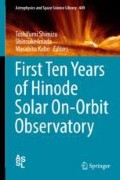Abstract
The source regions of the solar wind, and its driver and acceleration mechanism, remain key topics of study in heliophysics. With its combination of high sensitivity and high spatial resolution measurements of Doppler flows, mass motions, and plasma composition, the Hinode satellite is uniquely equipped to investigate many of these issues. On the occasion of the tenth anniversary of the launch of Hinode, we here briefly review some of the scientific highlights on this subject from the mission over the last decade.
Access this chapter
Tax calculation will be finalised at checkout
Purchases are for personal use only
References
Brooks, D.H., Warren, H.P.: Establishing a connection between active region outflows and the solar wind: abundance measurements with EIS/Hinode. Astrophys. J. Lett. 727, L13–L17 (2011)
Brooks, D.H., Warren, H.P.: The coronal source of extreme-ultraviolet line profile asymmetries in solar active region outflows. Astrophys. J. Lett. 760, L5–L10 (2012)
Brooks, D.H., et al.: Full-sun observations for identifying the source of the slow solar wind. Nat. Commun. 6, 5947 (2015). https://doi.org/10.1038/ncomms6947
Bryans, P., et al.: Multiple component outflows in an active region observed with the EUV imaging spectrometer on Hinode. Astrophys. J. 715, 1012–1020 (2010)
Cirtain, J.W., et al.: Evidence for Alfvén waves in solar X-ray jets. Science 318, 1580 (2007). https://doi.org/10.1126/science.1147050
Culhane, J.L., et al.: Tracking solar active region outflow plasma from its source to the near-Earth environment. Sol. Phys. 289, 3799–3816 (2014)
Del Zanna, G.: Flows in active region loops observed by Hinode EIS. Astron. Astrophys. 481, L49–L52 (2008)
Del Zanna, G., et al.: A single picture for solar coronal outflows and radio noise storms. Astron. Astrophys. 526, 137–148 (2011)
Doschek, G., et al.: Flows and nonthermal velocities in solar active regions observed with the EUV imaging spectrometer on Hinode: a tracer of active region sources of heliospheric magnetic fields? Astrophys. J. 686, 1362–1371 (2008)
Edwards, S.J., et al.: A comparison of global magnetic field skeletons and active-region upflows. Sol. Phys. 291, 117–142 (2016)
Feldman, U., Widing, K.G.: Elemental abundances in the solar upper atmosphere derived by spectroscopic means. Space Sci. Rev. 107, 665–720 (2003)
Feldman, U., et al.: On the sources of fast and slow solar wind. J. Geophys. Res. 110, A07109 (2005). https://doi.org/10.1029/2004JA010918
Geiss, G., et al.: Origin of the solar wind from composition data. Space Sci. Rev. 72, 49–60, (1995)
Guennou, C., et al.: Relative abundance measurements in plumes and interplumes. Astrophys. J. 807, 145–158 (2015)
Hara, H., et al.: Coronal plasma motions near footpoints of active region loops revealed from spectroscopic observations with Hinode EIS. Astrophys. J. Lett. 678, L67–L71 (2008)
Harra, L.K., et al.: Outflows at the edges of active regions: contribution to solar wind formation? Astrophys. J. Lett. 676, L147–L150 (2008)
Imada, S., et al.: Magnetic reconnection in non-equilibrium ionization plasma. Astrophys. J. 742, 70–80 (2011a)
Imada, S., et al.: One-dimensional modeling for temperature-dependent upflow in the dimming region observed by Hinode/EUV imaging spectrometer. Astrophys. J. 743, 57–67 (2011b)
Lee, K.-S., et al.: Photospheric abundances of polar jets on the Sun observed by Hinode. Astrophys. J. 809, 114–122 (2015)
Mandrini, C., et al.: Topological analysis of emerging bipole clusters producing violent solar events. Sol. Phys. 289, 2041–2071 (2014)
Mariska, J.T., et al.: Solar transition region response to variations in the heating rate. Astrophys. J. 255, 783–796 (1982)
Muller, D., et al.: Solar orbiter. Exploring the Sun-heliosphere connection. Sol. Phys. 285, 25–70 (2013)
Ofman, L., Davila, J.M.: Solar wind acceleration by large-amplitude nonlinear waves: parametric study. J. Geophys. Res. 103, 23677 (1998). https://doi.org/10.1029/98JA01996
Ofman, L., Davila, J.M.: Three-fluid 2.5-dimensional magnetohydrodynamic model of the effective temperature in coronal holes. Astrophys. J. 553, 935–940 (2001)
Parker, E.N.: Dynamics of the interplanetary gas and magnetic fields. Astrophys. J. 128, 664–676 (1958)
Sakao, T., et al.: Continuous plasma outflows from the edge of a solar active region as a possible source of solar wind. Science 318, 1585 (2007). https://doi.org/10.1126/science.1147292
Shibata, K., et al.: Observations of X-ray jets with the YOHKOH soft X-ray telescope. Pub. Astron. Soc. Jpn. 44, L173–L179 (1992)
Sterling, A.C., et al.: Small-scale filament eruptions as the driver of X-ray jets in solar coronal holes. Nature 523, 437–440 (2015). https://doi.org/10.1038/nature14556
Suzuki, T.K., Inutsuka, S.-I.: Making the corona and the fast solar wind: a self-consistent simulation for the low-frequency Alfvén waves from the photosphere to 0.3 AU. Astrophys. J. Lett. 632, L49–L52 (2005)
Teriaca, L., et al.: LEMUR: large European module for solar ultraviolet research. European contribution to JAXA’s solar-C mission. Exp. Astron. 34, 273–309 (2012)
von Steiger, R., et al.: Composition of quasi-stationary solar wind flows from Ulyssessolar wind ion composition spectrometer. J. Geophys. Res. 105, 27217 (2000). https://doi.org/10.1029/1999JA000358
Widing, K.G., Feldman, U.: On the rate of abundance modifications versus time in active region plasmas. Astrophys. J. 555, 426–434 (2001)
Wilhelm, K., Bodmer, R.: Solar EUV and UV emission line observations above a polar coronal hole. Space Sci. Rev. 85, 371–378 (1998)
Young, P.R., et al.: Temperature and density in a polar plume – measurements from CDS/SOHO. Astron. Astrophys. 350, 286–301 (1999)
Author information
Authors and Affiliations
Corresponding author
Editor information
Editors and Affiliations
Rights and permissions
Copyright information
© 2018 Springer Nature Singapore Pte Ltd.
About this chapter
Cite this chapter
Lee, KS., Brooks, D.H., Imada, S. (2018). The Origin of the Solar Wind. In: Shimizu, T., Imada, S., Kubo, M. (eds) First Ten Years of Hinode Solar On-Orbit Observatory. Astrophysics and Space Science Library, vol 449. Springer, Singapore. https://doi.org/10.1007/978-981-10-7742-5_9
Download citation
DOI: https://doi.org/10.1007/978-981-10-7742-5_9
Published:
Publisher Name: Springer, Singapore
Print ISBN: 978-981-10-7741-8
Online ISBN: 978-981-10-7742-5
eBook Packages: Physics and AstronomyPhysics and Astronomy (R0)

